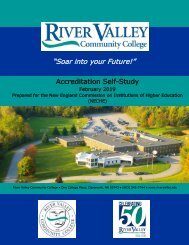You also want an ePaper? Increase the reach of your titles
YUMPU automatically turns print PDFs into web optimized ePapers that Google loves.
Registered students can see their charges online through the student SIS (Student<br />
Information System). Costs are published on the <strong>RVCC</strong> website and available through the<br />
Business Office. If a student chooses to borrow loans, they are required to complete<br />
Entrance Counseling which helps a student understand their rights and responsibilities as a<br />
loan borrower and also understand student loan debt and loan repayment. The Net Price<br />
Calculator, an online tool to help students and families estimate costs, is also available<br />
through <strong>RVCC</strong>’s website.<br />
River Valley also encourages students to apply for both need-based and merit scholarships<br />
through the <strong>RVCC</strong> website and through the CCSNH AwardSpring program, which matches<br />
students with potential scholarships.<br />
Appraisal of Admissions & Financial Aid<br />
<strong>RVCC</strong> works hard to support all students regardless of their past educational and personal<br />
experiences throughout all student services. The College has standard admission policies,<br />
and any program with special admissions requirements clearly identifies the policy in<br />
written admissions material.<br />
The advising processes for the co-requisite math courses have been clearly developed over<br />
the past two years in response to a change in the mathematics program at <strong>RVCC</strong>. The corequisite<br />
model is offered at all locations and allows students who would traditionally be<br />
placed into developmental courses to be placed into entry-level mathematics courses with<br />
real time support to mitigate the persistence factor. This model allows students to<br />
complete the entire developmental pathway throughout their time in their gateway<br />
mathematics course. This is done through an appropriate, structured, lab-model of extra<br />
learning. This model has shown promising results in the math department (Figure 5.2 –<br />
“Co-Requisite Math”, Rich Andrusiak, Department Chair, Math). The co-requisite model<br />
decreases time in college level Math completion and cost for students, and is showing<br />
excellent results in regards to student retention. This success is most visible when looking<br />
at the two-year success rate, defined as a student passing a gateway college Math course<br />
within two years of starting the math pathway. Previously, when using the traditional<br />
model of developmental coursework prior to a college level course, the pass rate was lower<br />
than the national average of 21%. In 2012, there was a redesign of the developmental<br />
pathway which resulted in an increase of the two-year pass rate to 34% (the first increase<br />
in the third column of Figure 5.2). This improvement continued between 2012 and 2017<br />
after the first math redesign. In Fall of 2017, with the implementation of the co-requisite<br />
model; pass rates of student taking college level math increased significantly to 76% and<br />
in Spring of 2018 to 94%. This is well beyond the national average of students in a<br />
developmental pathway. Even more interesting is that the co-requisite groups now have<br />
success rates similar to those students who do not require placement into the co-requisite<br />
programs, students who are considered “college ready” based on math advising. Success<br />
rates of non-co-requisite students was 78% in Fall 2017 and 88% in Spring 2018. Not<br />
only is <strong>RVCC</strong> now well above the national average for successful completion of a math<br />
class, regardless of entry level course, but co-requisite students are finding success in<br />
their college-level math classes at a rate equivalent to their peers who do not require<br />
additional math assistance. This success has allowed students who previously may be held<br />
up in their education due to lack of success in math to continue in their programs at the<br />
same rate as their peers.<br />
64 | P a g e





